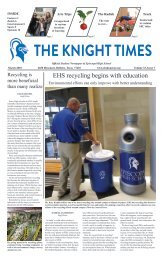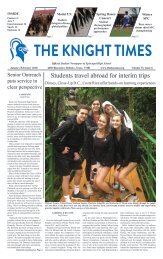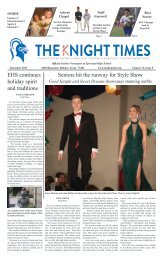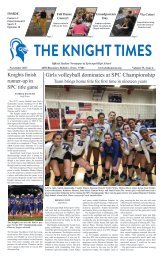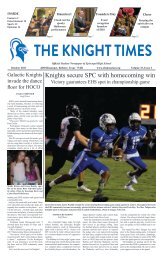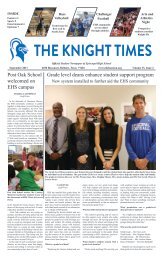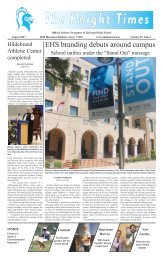THE KNIGHT TIMES - March 2018
You also want an ePaper? Increase the reach of your titles
YUMPU automatically turns print PDFs into web optimized ePapers that Google loves.
Opinion<br />
The Knight Times 11<br />
Technology may be to blame for Instant Gratification Generation<br />
SOPHIA HENRY<br />
Staff Writer<br />
Older generations are quick to call us<br />
lazy as they discuss their more interpersonal<br />
lives without cell phones and social<br />
media. They tell us of their fond memories<br />
of playing outside, writing love letters,<br />
and eating without technology at the table.<br />
This was a time before people could hide<br />
in their rooms and indulge in binge watching<br />
TV shows or gaming until 3 a.m. While<br />
past generations may refer to us as lazy,<br />
perhaps we are just more efficient or have<br />
a higher need for instant gratification.<br />
Today, anything can be delivered within<br />
moments: packages, food, clothes, flowers,<br />
furniture, groceries, answers to Google<br />
questions, and even a date. This contributes<br />
to a lack of patience as “we want what<br />
we want, and we want it now,” without any<br />
delay and minimum effort.<br />
Commercials are even becoming obsolete<br />
with Netflix, Hulu, Youtube (if one uses adblock),<br />
and pre-recorded shows; therefore,<br />
companies such as ABC and NBC have<br />
developed features to prevent their viewers<br />
from fastforwarding, but one can always<br />
pay more money to skip them. Ramesh Sitaraman,<br />
a computer science professor at<br />
the University of Massachusetts Amherst<br />
and researchers at Akamai Technologies<br />
Inc., who works with companies such as<br />
Major League Baseball and Fox Broadcasting<br />
Co to deliver faster videos, says<br />
that a video should start working within<br />
the first “two seconds” or people will begin<br />
to “abandon [the] video.” They studied<br />
over 23 million online streams and found<br />
that after two seconds, every proceeding<br />
one-second delay results in a 5.8 percent<br />
increase in viewers leaving the page.<br />
A society that experiences instantaneous<br />
feedback will slowly possess less and less<br />
patience. A graduate fresh out of college<br />
will join the workforce with disappointment<br />
as they are passed over for raises and<br />
promotions, and a lack of positive reinforcement<br />
may cause a struggle in staying<br />
motivated. Without the expected constant<br />
fulfillment, millennials feel frustrated as<br />
they lack a degree of patience for the “good<br />
Intellectual property rights<br />
can open tricky legal doors<br />
job” to come quickly. This instant gratification<br />
replaces lasting satisfaction with fleeting<br />
pleasure as we receive constant notification<br />
on our phones through text messages<br />
and social media updates. Instagram’s recent<br />
update even notifies users if people<br />
have commented on a photo they simply<br />
liked.<br />
The diagnosis of attention deficit disorder<br />
has skyrocketed in the last decade, and<br />
adults are beginning to be prescribed medication.<br />
In 2003, twelve percent of American<br />
children ages 5 to 17 were diagnosed<br />
with ADHD, and those numbers increased<br />
to 43 percent in 2011. This means that 5.8<br />
million children in the U.S. have ADHD.<br />
One must consider the cause of this enormous<br />
jump. Is it our instant gratification<br />
culture or a problem rooted in diagnosing<br />
kids too soon?<br />
Will our short attention spans prevent us<br />
from ever learning patience?<br />
ISABELLA GOODMAN<br />
Staff Writer<br />
Intellectual property is outlined as any<br />
product of human intellect that the law<br />
protects from unauthorized use by others,<br />
and can be protected through trademarks,<br />
patents, and copyrights. Intellectual property<br />
can be hard to clearly define, unlike<br />
physical property, because it pertains to<br />
ideas and concepts. Since the conception<br />
of intellectual property laws, there have<br />
been disagreements and controversy as to<br />
what constitutes intellectual property and<br />
who can reap the benefits.<br />
The first article and eighth section of the<br />
United States Constitution states that Congress<br />
issue copyrights, allowing people the<br />
exclusive rights to their creations. There<br />
have been countless high profile intellectual<br />
property cases where two entities fight<br />
over an idea that is potentially worth millions.<br />
In 2008, the creators of Barbie went<br />
head to head with a rival doll maker, Bratz.<br />
With similar designs and increasing popularity,<br />
the two went after each other; ultimately,<br />
the creators of Bratz were forced<br />
There are students at EHS<br />
who are making creations<br />
worthy of patents and copyright.<br />
to both remove all stock from shelves and<br />
pay $100 million. In Michael Baigent and<br />
Richard Leigh vs. The Random House<br />
Group, the writers of the non-fiction book,<br />
The Holy Blood and the Holy Grail, argued<br />
that Dan Brown’s The DaVinci Code<br />
infringed on their intellectual property.<br />
While Brown did not outright plagiarize<br />
their work, the two claimed that there was<br />
non-literal copying of a substantial portion<br />
of their book, and more specifically that<br />
he copied the manner in which their book<br />
had been written. The court decided that<br />
although Brown had clearly drawn from<br />
their book, he did not necessarily infringe<br />
copyright. One of the most famous cases<br />
of intellectual property law is the Napster<br />
case. Napster was a pioneering, file-sharing<br />
site where users could download songs<br />
for free instead of purchasing CDs. Popular<br />
bands signed to major labels, such as<br />
Metallica, were vocal in their animosity<br />
toward Napster. The site gained a huge following<br />
and as a result, garnered the attention<br />
of the Recording Industry Association<br />
of America (RIAA), who sued the emerging<br />
tech startup. Napster never owned the<br />
rights to the music that users were uploading<br />
and sharing; those rights belonged to<br />
the artists and their studios. Napster agreed<br />
to pay a $26 million settlement, and users<br />
now must pay licensing fees.<br />
While the idea of intellectual property or<br />
a personal disagreement as to who owns it<br />
may seem a distant possibility to a teenager,<br />
there are students at EHS who are making<br />
creations worthy of patents and copyright.<br />
In Mr. Duncan’s Computer Science<br />
Projects class, students are encouraged to<br />
follow their passions in computer science,<br />
whether that means creating apps, websites,<br />
and algorithms, or mining bitcoin. As<br />
a result, some students have questions as<br />
to the ownership of their ideas. If they created<br />
something in an EHS classroom, with<br />
an EHS computer, on EHS Wi-Fi, is it still<br />
solely theirs? If their product is believed<br />
to have monetary value, is EHS entitled to<br />
some form of financial compensation?<br />
The answer is a little complicated and<br />
would differ on a case-by-case basis. You<br />
will not find any clear-cut intellectual property<br />
guidelines in the Student Handbook<br />
because there are none. According to Mrs.<br />
Evelyn Cambria, the Director of Finance<br />
and Operations as well as the Chief Financial<br />
Officer of EHS, a creation is solely the<br />
student’s, and he or she would be encouraged<br />
to apply for a patent. For instance,<br />
when John Wall (’14) created wearable<br />
technology, he was encouraged to continue<br />
his work outside EHS. There are several<br />
students who have taken their technological<br />
creations and projects to college and<br />
beyond. Teachers, on the other hand, operate<br />
under a different guidelines. If a teacher<br />
creates something that is considered to be<br />
under the scope of his or her job, it not only<br />
belongs to the teacher but it also belongs to<br />
the school. If the teacher wanted to pursue<br />
the marketing of his or her idea, it would<br />
be the property of the school.<br />
As we move further into the age of technological<br />
advancement, intellectual property<br />
is something to consider. We have<br />
seen time and again a single idea leading<br />
to a billion-dollar enterprise. Intellectual<br />
property can be a tricky thing to deal with,<br />
and if you end up on the wrong side of an<br />
intellectual property battle, it can be damaging<br />
both financially and to the integrity<br />
of your business.<br />
The Knight Times<br />
Head of School<br />
Ned Smith<br />
Assistant Head of School<br />
Nancy Laufe Eisenberg<br />
Dean of Arts<br />
Jay Berckley<br />
Visual Arts Chair<br />
Kate Philbrick<br />
Publications Coordinator<br />
David Framel<br />
Photojournalism Instructor<br />
Jaime Sonnier<br />
Photojournalism Editor<br />
Miranda Greenwalt<br />
Episcopal High School<br />
4650 Bissonnet, Bellaire, TX 77450<br />
713-512-3400<br />
Image courtesy of amazon.com.<br />
Editor-in-Chief<br />
Lauren Porter<br />
Managing Editor<br />
Sydney Hutchins<br />
Contributing Editor<br />
Cami Pyne<br />
Staff Writers<br />
Ellie Ragiel<br />
Isabel Young<br />
Isabella Goodman<br />
Angel Stringer<br />
Sophia Henry<br />
Preston Witt<br />
Patrick Bayouth<br />
Elliott Jones<br />
Daniel Davis<br />
Gabrielle Ducote<br />
Photographers<br />
Teagan Ashworth, Chris Castro Janecki, Cara Kennedy, Lane McCool, Mason Morris, Parker<br />
Nickerson, Julia Toups, Trinity Watts, Hannah Windle, Rohan Asthana, Phoebe Crow, Layton<br />
Debes, Caroline Fertitta, Elliott Jones, Robert Mason, Taylor Ranucci, James Henry Ray,<br />
Stockton Shaffer, Madison Stanke, Sophie Thomas, Sasha Vermeil, Rachel Boeker,<br />
Sydney Bosarge, Kaveinga Davis, Will Davis, Spencer Donley, Cydne Harrell-Malveaux,<br />
Amber Hatfield, Alexandra Herrera, Sadie Jensen, Elliott Leathers, Chloe Masterson,<br />
Luke Pugh, Ethan Tuckwood, Luke White, Alan Ayanegui, Christina Betti, Isabel Frasier,<br />
Sophia Pamphilis, Margaret Runnels, Sophia Wayne, David Bebczuk, Sydney Cooper,<br />
Alex Deutsch, Elizabeth Anne Charbonnet, Sophia Haugh, Sadie Jensen, Lindsey Little,<br />
Anna McLauchlin, Julia Nasser, Chandler Onyekwelu, Kate Peterkin,<br />
Lexi Sagers, Madelyn Scholtes, Amelia Traylor, Celine Waxham<br />
The Knight Times is a product of students in the Episcopal High School newspaper class, who are<br />
solely responsible for its creation and editorial content. The opinions expressed are those of the<br />
writer and do not necessarily represent those of the Episcopal Board of Trustees, administration,<br />
faculty, and staff. Published ten times a year, The Knight Times is a non-profit educational tool.<br />
The staff encourages the submission of letters, editorials, and story ideas from the community<br />
but reserves the right to edit and/or use said articles.











